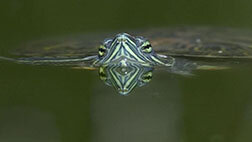Poor Prognosis for Turtles if Removed from South Pond
I have noticed a great many Facebook posts mention the turtles at Reid Park. Thought you'd like to learn a bit more about them and how the proposed changes would affect them.
The majority of the turtles at Reid Park are Red-eared Sliders. These turtles are native to the Mississippi Drainage area, from Ohio west to Iowa, south to the Gulf of Mexico, through eastern Texas and down into extreme northeastern Mexico. These were the famous "dime store" turtles, still commonly sold in pet shops.
They have been introduced in many locations worldwide and are considered invasive pest species in many areas. They can grow up to 11 inches in straight-line carapace (SLC) length (measured from the upper shell’s front edge to its back edge). These turtles are actively breeding at Reid Park.
The second most common turtle at Reid Park is Emory's Soft-shelled Turtle, also called the Texas Spiny Soft-shelled Turtle. They are among the largest turtles in North America, ranging throughout central and western Texas and along the Pecos and Rio Grande Rivers into southern New Mexico.
How and when they were introduced in Arizona is uncertain, but they are found extensively throughout the state, wherever water is available. They can reach SLC lengths of up to 16 inches. These, too, are breeding in the park.
In addition, you may encounter various species of Pond Cooter, River Cooter, Painted Turtle, and Yellow-bellied Sliders—all introduced from elsewhere. Rumor has it that the South Pond is home to an African Giant Soft-shelled Turtle. A single Argentine Side-necked Turtle was also recovered there, and now resides at the Reid Park Zoo. There is no evidence that any of these species are breeding at Reid Park.
To my knowledge, there are no native Sonoran Mud Turtles at Reid Park, nor would that be expected, given the man-made nature of the ponds.
Obviously, the elimination of the South Pond will affect the turtles in many adverse ways. It will cause a migration to the North Pond, if barrier fencing doesn't bar their movement. This will temporarily result in overpopulation, and some deaths will undoubtedly result.
Furthermore, the North Pond, due to the walkway surrounding its perimeter, provides no basking opportunities. For many of these species basking, or sunning, is vital for many metabolic processes in reptiles, as it helps with growth and parasite control. Currently, the stream that extends between the North and South Ponds allows turtles to travel between the two. The basking opportunities in the South Pond are now available for all of Reid Park's turtles, but they won’t be for much longer if the current plans are not halted.
The North Pond design (again, without access to the South Pond) will also effectively stop breeding in a most cruel and deadly way. Without an egress, gravid female turtles will have no way to nest. This can (and often does) lead to egg binding and a slow, painful death for the females. Because many turtle species can produce eggs for up to seven years after last breeding, there's a good chance that the vast majority of Reid Park's female Sliders and Soft-shelled Turtles will succumb.
Hate to give y'all such a poor prognosis for Reid Park's turtle population, but I felt you should know.
— Pete Polley, Letter to Save the Heart of Reid Park, December 23, 2020

